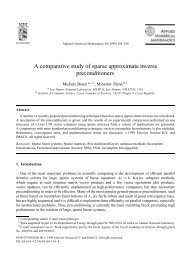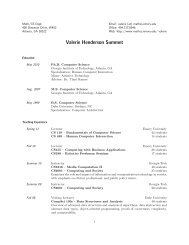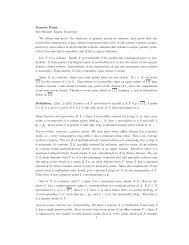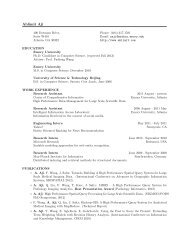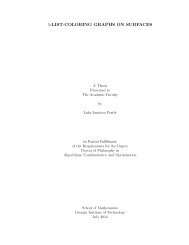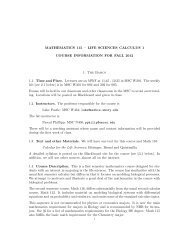Chapter 3 Solution of Linear Systems - Math/CS
Chapter 3 Solution of Linear Systems - Math/CS
Chapter 3 Solution of Linear Systems - Math/CS
You also want an ePaper? Increase the reach of your titles
YUMPU automatically turns print PDFs into web optimized ePapers that Google loves.
68 CHAPTER 3. SOLUTION OF LINEAR SYSTEMS<br />
to a large change in the solution x <strong>of</strong> the linear system Ax = b. An example <strong>of</strong> an ill–conditioned<br />
linear system is presented at the end <strong>of</strong> this section.<br />
What factors determine whether a linear system is well–conditioned or ill–conditioned? Theory<br />
tells us that an important factor is the distance from the matrix A to the “closest” singular matrix.<br />
In particular, the linear system Ax = b is ill–conditioned when the matrix A is close to a singular<br />
matrix.<br />
How do the concepts <strong>of</strong> well–conditioned and ill–conditioned linear systems apply to the computed<br />
solution <strong>of</strong> Ax = b? Backward error analysis shows that the approximate solution computed by GE<br />
<strong>of</strong> the linear system Ax = b is the exact solution <strong>of</strong> a related linear system A ′ x = b ′ . Usually, A ′<br />
is close to A and b ′ is close to b. In this case, if Ax = b is well–conditioned, then it follows that<br />
the computed solution is accurate. On the other hand, if Ax = b is ill–conditioned, then even if A ′<br />
is close to A and b ′ is close to b, these small differences may lead to a large difference between the<br />
solution <strong>of</strong> Ax = b and the solution <strong>of</strong> A ′ x = b ′ , and the computed solution may not be accurate.<br />
In summary, we draw the following conclusions about the computed solution <strong>of</strong> the linear system<br />
Ax = b. Suppose GE, when applied to this linear system, is stable. If the linear system is well–<br />
conditioned, then the computed solution is accurate. On the other hand, if this linear system<br />
ill–conditioned, then the computed solution may not be accurate.<br />
A measure <strong>of</strong> the conditioning <strong>of</strong> a linear system is the condition number <strong>of</strong> the matrix A <strong>of</strong> the<br />
system. This measure, which is defined more precisely in advanced numerical analysis textbooks, is<br />
the product <strong>of</strong> the “size” <strong>of</strong> the matrix A and the “size” <strong>of</strong> its inverse A −1 . This quantity is always<br />
greater than one; it is one for the identity matrix (that is, a diagonal matrix with ones on the main<br />
diagonal). In general the larger the condition number, the more ill-conditioned the matrix and the<br />
more likely that the solution <strong>of</strong> the linear system will be inaccurate. To be more precise, if the<br />
condition number <strong>of</strong> A is about 10 p and the machine epsilon, ɛ, is about 10 −s then the solution <strong>of</strong><br />
the linear system Ax = b is unlikely to be more than about s − p decimal digits accurate. Recall<br />
that in SP arithmetic, s ≈ 7, and in DP arithmetic, s ≈ 15. Functions for estimating the condition<br />
number <strong>of</strong> any matrix A fairly inexpensively are available in most high quality numerical s<strong>of</strong>tware<br />
libraries; some remarks on this are given in Section 3.5.<br />
We conclude this section by describing two ways <strong>of</strong> how not to attempt to estimate the accuracy<br />
<strong>of</strong> a computed solution. We know that det(A) = 0 when the linear system Ax = b is singular. So,<br />
we might assume that the magnitude <strong>of</strong> det(A) might be a good indicator <strong>of</strong> how close the matrix<br />
A is to a singular matrix. Unfortunately, this is not the case.<br />
Consider, for example, the two linear systems:<br />
⎡<br />
1<br />
⎣ 0<br />
0<br />
1<br />
⎤ ⎡<br />
0<br />
0 ⎦ ⎣<br />
0 0 1<br />
x1<br />
x2<br />
⎤ ⎡<br />
⎦ = ⎣ 1<br />
⎤<br />
2 ⎦ and<br />
⎡<br />
⎣<br />
3<br />
x3<br />
0.5 0 0<br />
0 0.5 0<br />
0 0 0.5<br />
⎤ ⎡<br />
⎦<br />
⎣ x1<br />
x2<br />
x3<br />
⎤ ⎡<br />
⎦ = ⎣ 0.5<br />
⎤<br />
1.0 ⎦<br />
1.5<br />
where the second is obtained from the first by multiplying each <strong>of</strong> its equations by 0.5. The determinant<br />
<strong>of</strong> the coefficient matrix <strong>of</strong> the first linear system is 1 and for the second linear system it<br />
is 0.125. So, by comparing the magnitude <strong>of</strong> these determinants, we might believe that GE would<br />
produce a less accurate solution <strong>of</strong> the second linear system. However, GE produces identical solutions<br />
for both linear systems because each linear system is diagonal, so no exchanges or eliminations<br />
need be performed. We conclude, that the magnitude <strong>of</strong> the determinant is not necessarily a good<br />
indicator <strong>of</strong> how close a coefficient matrix is to the nearest singular matrix.<br />
Another test you might consider is to check how well the approximate solution x determined<br />
by GE satisfies the original linear system Ax = b. The residuals r1, r2, · · · , rn associated with the<br />
approximate solution x are defined as<br />
r1 = b1 − a1,1x1 − a1,2x2 − · · · − a1,nxn<br />
r2 = b2 − a2,1x1 − a2,2x2 − · · · − a2,nxn<br />
.<br />
rn = bn − an,1x1 − an,2x2 − · · · − an,nxn<br />
Observe that rk = 0 when the approximate solution x satisfies the k th equation, so the magnitudes



